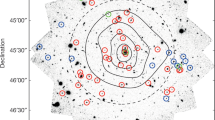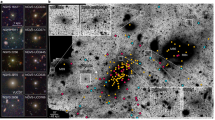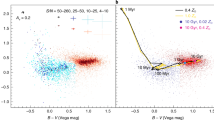Abstract
Massive galaxies are thought to form in two phases: an initial collapse of gas and giant burst of central star formation, followed by the later accretion of material that builds up their stellar and dark-matter haloes1,2,3,4. The systems of globular clusters within such galaxies are believed to form in a similar manner. The initial central burst forms metal-rich (spectrally red) clusters, whereas more metal-poor (spectrally blue) clusters are brought in by the later accretion of less-massive satellites5,6,7,8,9,10. This formation process is thought to result in the multimodal optical colour distributions that are seen in the globular cluster systems of massive galaxies8,11,12. Here we report optical observations of the massive relic-galaxy candidate NGC 1277—a nearby, un-evolved example of a high-redshift ‘red nugget’ galaxy13,14,15,16,17. We find that the optical colour distribution of the cluster system of NGC 1277 is unimodal and entirely red. This finding is in strong contrast to other galaxies of similar and larger stellar mass, the cluster systems of which always exhibit (and are generally dominated by) blue clusters11. We argue that the colour distribution of the cluster system of NGC 1277 indicates that the galaxy has undergone little (if any) mass accretion after its initial collapse, and use simulations of possible merger histories to show that the stellar mass due to accretion is probably at most ten per cent of the total stellar mass of the galaxy. These results confirm that NGC 1277 is a genuine relic galaxy and demonstrate that blue clusters constitute an accreted population in present-day massive galaxies.
This is a preview of subscription content, access via your institution
Access options
Access Nature and 54 other Nature Portfolio journals
Get Nature+, our best-value online-access subscription
$29.99 / 30 days
cancel any time
Subscribe to this journal
Receive 51 print issues and online access
$199.00 per year
only $3.90 per issue
Buy this article
- Purchase on Springer Link
- Instant access to full article PDF
Prices may be subject to local taxes which are calculated during checkout




Similar content being viewed by others
References
Khochfar, S. & Silk, J. A simple model for the size evolution of elliptical galaxies. Astrophys. J. 648, L21–L24 (2006)
Oser, L ., Naab, T ., Ostriker, J. P . & Johansson, P. H. The cosmological size and velocity dispersion evolution of massive early-type galaxies. Astrophys. J. 744, 63 (2012)
Ceverino, D ., Dekel, A ., Tweed, D. & Primack, J. Early formation of massive, compact, spheroidal galaxies with classical profiles by violent disc instability or mergers. Mon. Not. R. Astron. Soc. 447, 3291–3310 (2015)
van Dokkum, P. G . et al. The growth of massive galaxies since z=2. Astrophys. J. 709, 1018–1041 (2010)
Searle, L. & Zinn, R. Compositions of halo clusters and the formation of the galactic halo. Astrophys. J. 225, 357–379 (1978)
Côté, P ., Marzke, R. O. & West, M. J. The formation of giant elliptical galaxies and their globular cluster systems. Astrophys. J. 501, 554–570 (1998)
Beasley, M. A ., Baugh, C. M ., Forbes, D. A ., Sharples, R. M. & Frenk, C. S. On the formation of globular cluster systems in a hierarchical Universe. Mon. Not. R. Astron. Soc. 333, 383–399 (2002)
Tonini, C. The metallicity bimodality of globular cluster systems: a test of galaxy assembly and of the evolution of the galaxy mass-metallicity relation. Astrophys. J. 762, 39 (2013)
Leaman, R ., VandenBerg, D. A. & Mendel, J. T. The bifurcated age–metallicity relation of Milky Way globular clusters and its implications for the accretion history of the galaxy. Mon. Not. R. Astron. Soc. 436, 122–135 (2013)
Kruijssen, J. M. D. Globular clusters as the relics of regular star formation in normal high-redshift galaxies. Mon. Not. R. Astron. Soc. 454, 1658–1686 (2015)
Peng, E. W . et al. The ACS Virgo Cluster Survey. IX. The color distributions of globular cluster systems in early-type galaxies. Astrophys. J. 639, 95–119 (2006)
Brodie, J. P. & Strader, J. Extragalactic globular clusters and galaxy formation. Annu. Rev. Astron. Astrophys. 44, 193–267 (2006)
Damjanov, I . et al. Red nuggets at z=1.5. Compact passive galaxies and the formation of the Kormendy relation. Astrophys. J. 695, 101–115 (2009)
van den Bosch, R. C. E . et al. An over-massive black hole in the compact lenticular galaxy NGC 1277. Nature 491, 729–731 (2012)
Trujillo, I ., Ferré-Mateu, A ., Balcells, M ., Vazdekis, A. & Sánchez-Blázquez, P. NGC 1277: a massive compact relic galaxy in the nearby Universe. Astrophys. J. 780, L20 (2014)
Martín-Navarro, I . et al. The initial mass function of a massive relic galaxy. Mon. Not. R. Astron. Soc. 451, 1081–1089 (2015)
Yıldırım, A . et al. The structural and dynamical properties of compact elliptical galaxies. Mon. Not. R. Astron. Soc. 468, 4216–4245 (2017)
Hargis, J. R. & Rhode, K. L. Globular cluster systems and their host galaxies: comparison of spatial distributions and colors. Astrophys. J. 796, 62 (2014)
Blakeslee, J. P . et al. Optical and infrared photometry of globular clusters in NGC 1399: evidence for color–metallicity nonlinearity. Astrophys. J. 746, 88 (2012)
Yoon, S.-J . et al. Nonlinear color-metallicity relations of globular clusters. III. On the discrepancy in metallicity between globular cluster systems and their parent elliptical galaxies. Astrophys. J. 743, 150 (2011)
Chies-Santos, A. L . et al. An optical/NIR survey of globular clusters in early-type galaxies. III. On the colour bimodality of globular cluster systems. Astron. Astrophys. 539, A54 (2012)
Read, J. I ., Wilkinson, M. I ., Evans, N. W ., Gilmore, G. & Kleyna, J. T. The tidal stripping of satellites. Mon. Not. R. Astron. Soc. 366, 429–437 (2006)
Szomoru, D ., Franx, M. & van Dokkum, P. G. Sizes and surface brightness profiles of quiescent galaxies at z=2. Astrophys. J. 749, 121 (2012)
Yıldırım, A . et al. MRK 1216 and NGC 1277 – an orbit-based dynamical analysis of compact, high-velocity dispersion galaxies. Mon. Not. R. Astron. Soc. 452, 1792–1816 (2015)
Toft, S . et al. A massive, dead disk galaxy in the early Universe. Nature 546, 510–513 (2017)
Wellons, S . et al. The diverse evolutionary paths of simulated high-z massive, compact galaxies to z=0. Mon. Not. R. Astron. Soc. 456, 1030–1048 (2016)
Furlong, M . et al. Size evolution of normal and compact galaxies in the EAGLE simulation. Mon. Not. R. Astron. Soc. 465, 722–738 (2017)
Muratov, A. L. & Gnedin, O. Y. Modeling the metallicity distribution of globular clusters. Astrophys. J. 718, 1266–1288 (2010)
Bertin, E. & Arnout, S. SExtractor: software for source extraction. Astron. Astrophys. Suppl. Ser. 117, 393–404 (1996)
Bertin, E. Automated morphometry with SExtractor and PSFEx. ASP Conf. Ser. 442, 435–438 (2011)
Schlafly, E. F . & Finkbeiner, D. P. Measuring reddening with Sloan Digital Sky Survey stellar spectra and recalibrating SFD. Astrophys. J. 737, 103 (2011)
Bohlin, R. C. Perfecting the photometric calibration of the ACS CCD cameras. Astron. J. 152, 60 (2016)
Scott, D. W. Multivariate Density Estimation: Theory, Practice, and Visualization 7–11 (John Wiley & Sons, 1992)
Pota, V. et al. The SLUGGS survey: kinematics for over 2500 globular clusters in 12 early-type galaxies. Mon. Not. R. Astron. Soc. 428, 389–420 (2013)
Sérsic, J. L. The influence of the atmospheric and instrumental dispersion on the brightness distribution in a galaxy. Bol. Asoc. Argentina Astron. 6, 41–43 (1963)
Ferrarese, L. et al. A database of Cepheid distance moduli and tip of the red giant branch, globular cluster luminosity function, planetary nebula luminosity function, and surface brightness fluctuation data useful for distance determinations. Astrophys. J. Suppl. Ser. 128, 431–459 (2000)
Secker, J. & Harris, W. E. A maximum likelihood analysis of globular cluster luminosity distributions in the Virgo ellipticals. Astron. J. 105, 1358–1368 (1993)
Jordán, A. et al. The ACS Virgo Cluster Survey. XII. The luminosity function of globular clusters in early-type galaxies. Astrophys. J. Suppl. Ser. 171, 101–145 (2007)
Peng, E. W. et al. The ACS Virgo Cluster Survey. XV. The formation efficiencies of globular clusters in early-type galaxies: the effects of mass and environment. Astrophys. J. 681, 197–224 (2008)
Harris, W. E. et al. Globular cluster systems in brightest cluster galaxies. bimodal metallicity distributions and the nature of the high-luminosity clusters. Astrophys. J. 636, 90–114 (2006)
Strader, J., Brodie, J. P., Spitler, L. & Beasley, M. A. Globular clusters in Virgo ellipticals: unexpected results for giants and dwarfs from advanced camera for surveys imaging. Astron. J. 132, 2333–2345 (2006)
Mieske, S. et al. The ACS Fornax Cluster Survey. IX. The color–magnitude relation of globular cluster systems. Astrophys. J. 710, 1672–1682 (2010)
Poggianti, B. M. et al. Superdense galaxies and the mass-size relation at low redshift. Astrophys. J. 762, 77 (2013)
Valentinuzzi, T. et al. Superdense massive galaxies in wings local clusters. Astrophys. J. 712, 226–237 (2010)
Peralta de Arriba, L., Quilis, V., Trujillo, I., Cebrián, M. & Balcells, M. Massive relic galaxies prefer dense environments. Mon. Not. R. Astron. Soc. 461, 156–163 (2016)
Damjanov, I., Zahid, H. J., Geller, M. J. & Hwang, H. S. The environment of massive quiescent compact galaxies at 0.1<z<0.4 in the COSMOS field. Astrophys. J. 815, 104 (2015)
Stringer, M., Trujillo, I., Dalla Vecchia, C. & Martinez-Valpuesta, I. A cosmological context for compact massive galaxies. Mon. Not. R. Astron. Soc. 449, 2396–2404 (2015)
Trujillo, I. et al. Superdense Massive Galaxies in the Nearby Universe. Astrophys. J. 692, L118–L122 (2009)
Taylor, E. N. et al. On the dearth of compact, massive, red sequence galaxies in the local Universe. Astrophys. J. 720, 723–741 (2010)
Leauthaud, A. et al. New constraints on the evolution of the stellar- to-dark matter connection: a combined analysis of galaxy-galaxy lensing, clustering, and stellar mass functions from z=0.2 to z=1. Astrophys. J. 744, 159 (2012)
Kirby, E. N. et al. The Universal stellar mass-stellar metallicity relation for dwarf galaxies. Astrophys. J. 779, 102 (2013)
Georgiev, I. Y., Puzia, T. H., Goudfrooij, P. & Hilker, M. Globular cluster systems in nearby dwarf galaxies – III. Formation efficiencies of old globular clusters. Mon. Not. R. Astron. Soc. 406, 1967–1984 (2010)
Acknowledgements
We thank C. dalla Vecchia, J. Sanchez Almeida, C. Brook, S. Wellons, M. Fouesneau, A. Vazdekis, B. Dullo, J. Read and G. van de Ven for discussions, and J. Roman and A. Serrano Borlaf for assistance with image alignment. M.A.B. and I.T. acknowledge support from grant AYA2016-77237-C3-1-P from the Spanish Ministry of Economy and Competitiveness (MINECO). R.L. acknowledges funding from a Natural Sciences and Engineering Research Council of Canada PDF award. This research has made use of the NASA/IPAC Extragalactic Database (NED), which is operated by the Jet Propulsion Laboratory, California Institute of Technology, under contract with NASA, and is based on observations made with the NASA/ESA Hubble Space Telescope, which is operated by the Association of Universities for Research in Astronomy under NASA contract NAS 5-26555. These observations are associated with programme GO-14215. Support for this work was provided by NASA through grant HST-GO-4215 from the Space Telescope Science Institute, operated by AURA under NASA contract NAS 5-26555 This research has made use of NASA’s Astrophysics Data System and extensive use of Python and Scipy.
Author information
Authors and Affiliations
Contributions
M.A.B. led the data processing and analysis, contributed to the interpretation and HST proposal preparation and produced Figs 1, 2, 3 and Extended Data Figs 2, 3, 4, 5, 6. I.T. contributed to the analysis and the interpretation, produced Extended Data Fig. 1 and lead the HST proposal preparation. R.L. generated and analysed the analytic merger models, produced Fig. 4 and Extended Data Figs 7, 8, and contributed to the analysis, interpretation and HST proposal preparation. M.M. contributed to the analysis, interpretation and HST proposal preparation. All authors contributed to the overall design of this project.
Corresponding author
Ethics declarations
Competing interests
The authors declare no competing financial interests.
Additional information
Reviewer Information Nature thanks R. Abraham, K. Glazebrook and L. Spitler for their contribution to the peer review of this work.
Publisher's note: Springer Nature remains neutral with regard to jurisdictional claims in published maps and institutional affiliations.
Extended data figures and tables
Extended Data Figure 1 Colour-composite HST image of the massive relic galaxy NGC 1277.
The image was constructed from g475W + r625W + z850LP bands. The g475W and z850LP imaging was obtained with the HST programme GO-14215 and the r625W imaging with the programme GO-10546. NGC 1277 is the best example found so far in the nearby Universe with characteristics equivalent to those of the first massive galaxies to form more than 11 Gyr ago. The image is oriented with north pointing up and east to the left. The field of view is 42.2 arcsec × 30.6 arcsec, corresponding to a physical scale of 14.5 kpc × 10.5 kpc at our adopted distance of 73.3 Mpc to the galaxy. The images have been scaled with logarithmic intensity to highlight the various structures in the galaxy. The vast majority of point sources surrounding NGC 1277 are clusters associated with the galaxy. Two example clusters have been marked with ticks.
Extended Data Figure 2 Colour–magnitude diagrams of cluster candidates.
From left to right, the plots show all point sources in the field, NGC 1278 clusters, raw (not background-corrected) NGC 1277 clusters and an example background field. Also shown are the photometric uncertainties (1σ; blue crosses) based on our artificial point-source test, and the 100% completeness limit (red dashed lines; see Methods).
Extended Data Figure 3 Surface-density profile of NGC 1277 clusters.
The figure shows the raw (blue circles) and completeness-corrected (orange stars) counts. Uncertainties are 16th–84th percentiles. Within the range 3–10 kpc, the clusters closely follow the light distribution of the galaxy. This is typical of red clusters. The background is determined from the Sérsic function fits (which include a background term; green line) to the cluster data and defines the radial extent of the cluster system, which ends at 11 kpc (about 10Re). The stellar-mass density profile15 (red line) has arbitrary normalization. GCs, globular clusters.
Extended Data Figure 4 Colour distribution of clusters in NGC 1277 compared with that for the companion galaxy in projection NGC 1278.
The figure shows that NGC 1278 (blue) has a strong peak of blue clusters that is not seen in NGC 1277 (orange). The expected background contamination of NGC 1278 clusters and of intracluster clusters to the cluster system of NGC 1277, with which we have corrected the colour distribution of NGC 1277, is also shown (green). The predominantly blue colours of the contaminating clusters is expected because they correspond to the outskirts of NGC 1278 (see Fig. 1). Solid curves are two-Gaussian solutions from the GMM code28; dashed curves are individual Gaussian components from GMM. A single Gaussian fit to the NGC 1277 clusters with GMM gives 〈g475W − z850LP〉 = 1.22 ± 0.03, with a FWHM of 0.28 ± 0.02.
Extended Data Figure 5 Distribution of the blue cluster fraction from Monte Carlo simulations.
The vertical dashed lines indicate the medians of the distributions and the vertical dotted lines show the 16th and 84th percentiles.
Extended Data Figure 6 Colour distributions of NGC 1277 and NGC 1278 in three magnitude bins.
The bin values for the NGC 1277 clusters represent the medians of the bin values from Monte Carlo simulations. Uncertainties are the 16th–84th percentiles of the distributions.
Extended Data Figure 7 Accretion models for the build-up of the NGC 1277 cluster system.
Each point is a single merger history for NGC 1277, characterized by the total fraction of accreted stellar mass versus the number ratio of in situ to accreted clusters for that realization. The observed ratio for NGC 1277 is indicated by the cyan dashed line (Nblue/Nred = 0.21) and is characteristic of galaxies with merger histories leading to facc ≈ 10% (orange). The cyan arrow indicates that the in situ fraction is a lower limit. Galaxies with comparable stellar mass to NGC 1277 in the ACS VCS tend to have equal numbers of blue and red clusters, which is more common for accretion histories of facc ≈ 50%–90% (green). The extremely rare (about 0.02%) high-mass-accretion realizations, which produce the observed blue/red fraction in NGC 1277, are shown in magenta. Contours represent 10%, 25%, 50%, 75%, 90% and 99% of the maximum of the two-dimensional distribution.
Extended Data Figure 8 Predictions of galaxy properties from accretion models.
From left to right, the black lines show the accretion fraction, the number of mergers, the maximum mass ratio of the merger and the final ratio of stellar to dark-matter mass for all of the merger realizations. The magenta distributions (top) show the high-facc merger histories that satisfy the constraint on the colour ratio of the clusters (which happens rarely; see, for example, Extended Data Fig. 7). The cyan distributions (bottom) show the low-facc merger histories that satisfy the observed colour ratio of the clusters and the SN constraints. The high-accretion-fraction models (magenta) also predict a dark-matter-halo mass for NGC 1277 that is larger than the observational constraints17 (indicated by the arrow in the bottom right panel). The vertical dashed lines represent the median of the distributions and the vertical dotted lines show the 16th and 84th percentiles.
Rights and permissions
About this article
Cite this article
Beasley, M., Trujillo, I., Leaman, R. et al. A single population of red globular clusters around the massive compact galaxy NGC 1277. Nature 555, 483–486 (2018). https://doi.org/10.1038/nature25756
Received:
Accepted:
Published:
Issue Date:
DOI: https://doi.org/10.1038/nature25756
Comments
By submitting a comment you agree to abide by our Terms and Community Guidelines. If you find something abusive or that does not comply with our terms or guidelines please flag it as inappropriate.



